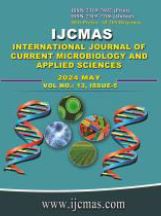


 National Academy of Agricultural Sciences (NAAS)
National Academy of Agricultural Sciences (NAAS)

|
PRINT ISSN : 2319-7692
Online ISSN : 2319-7706 Issues : 12 per year Publisher : Excellent Publishers Email : editorijcmas@gmail.com / submit@ijcmas.com Editor-in-chief: Dr.M.Prakash Index Copernicus ICV 2018: 95.39 NAAS RATING 2020: 5.38 |
The Gangetic area of Bihar is plagued by a serious health problem called Acute Encephalitic Syndrome popularly known as Chamki Bukhar, where the chamki means seizures. The most impacted age range is 1 to 15 years old. In Bihar, the syndrome is also known as, litchi fever, and Navkabukhar (Civils daily, 2021; https://www.bhaskar.com/national/news/chamki-fever-kills-more-than-125-kids-in-bihar-01573751.html, 2023). Children who suffer from the acute neurological disease Chamki Bukhar have a significant case fatality rate (CFR). In 1995, Muzaffarpur and the surrounding areas received the first reports of it. The condition, which affects the central nervous system, can result in serious problems, epileptic convulsions, and even death. The CFR of this illness is extremely high, and survivors may experience varying degrees of neurological damage. A quarter of the affected youngsters are thought to pass away, and of those who do, between 30 and 40 percent experience physical and mental damage. Clinical symptoms of Chamki Bukhar include the development of an acute febrile illness, altered mental status, including confusion, disorientation, speech impediment, and coma, together with or without a recent onset of seizures. In 2014, the CFR is 355. Since 1995, the instance of Chamki Bukhar in the Gangetic area of Bihar has been reported annually, primarily in the months of April to October. Despite efforts by research organisations and national and international health agencies, there is still no tangible remedy. Since many etiological explanations have been proposed, but none have been conclusively proven. Therefore, the Unani System of Medicine (USM), which gives a logical approach in even emerging and new diseases, must be used to address and explore this serious health concern. This article will lay the groundwork for a novel strategy, idea, and resolution that could mark a turning point in future research on Chamki Bukhar
Civils daily. Available from https://www.civilsdaily.com /burning-issue-acute-encephalitis-syndrome-aes/(Cited on 20-09-2021).
https://www.bhaskar.com/national/news/chamki-fever-kills-more-than-125-kids-in-bihar-01573751.html (Cited on 15.05.2023)
Operational guidelines. National programme for prevention and control of JE/AES. National vector born disease control programme, Director general of Health Services Ministry of Health & family welfare, Govt. of India. Delhi.2014.
Jain P, Prakash S, Khan D N et al., Aetiology of acute encephalitis syndrome in Uttar Pradesh, India from 2014 to 2016. J Vector Borne Dis 2017:311–316.
Jain P, Jain A, Kumar A et al., Epidemiology and etiology of acute encephalitis syndrome in North India. Jpn J Infect Dis. 2014;67(3):197-203.
John T J, Verghese V P, Kumar A G. The syndrome of acute encephalitis in children in India: need for new thinking. The Indian journal of medical research. 2017;146(2):158.
Kirmani N A. Moalajate Sharha-e-Asbab (Complete translation by Mohammad Kabiruddin). Idara Kitabul Shifa. New Delhi. 2011:45-53.
Ibn Sina. Kulliyat e Qanoon, Part 2. (Urdu translated by Hakim Kabiruddin). Idara Kitabul Shifa. New Delhi. 2015:1-60.
Khan M A. Akseereazam (Urdu translation by Hakim Mohammad Kabiruddin). Ejaz Publishing house. New Delhi. 2010: 83-99.
Prevention & Management of Chamki Bukhar–A Standard Operating Procedure (SOP). Department of Health, Govt of Bihar. 2020;19,53.
 |
 |
 |
 |
 |